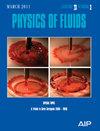深度强化学习减阻崖体波浪的流动拓扑图
IF 4.1
2区 工程技术
Q1 MECHANICS
引用次数: 0
摘要
本文介绍并讨论了一个崖体的尾流拓扑结构,该崖体是商用公路车辆的代表,通过不同的控制法则对位于模型尾部边缘的脉冲喷流进行控制。先前的工作已经确定了控制法则的参数,其中在不同条件下对深度强化学习(DRL)算法进行了训练,以首先实现阻力减小,同时将能量预算考虑在内。这项工作的重点是了解 DRL 代理在四种不同情况下,通过不同大小的状态和奖励定义达到目标的机制。在机体尾流的不同平面进行了平面和立体粒子图像测速测量。研究结果表明,当达到较大的阻力减小条件时,再循环流气泡在流向方向上缩短,尾流在流向垂直面上沿横流方向的对称站处变得对称,模型底部的压力大幅恢复。在这些条件下,湍流拓扑结构与自然情况下的湍流拓扑结构相比发生了巨大变化。相反,当引入能量预算时,由于驱动力减弱,再循环流气泡的变化较小。因此,这项研究在对之前的流动物理分析工作进行补充的同时,也为通过主动流动控制策略减少压力阻力时所应采用的尾流拓扑结构提供了有价值的见解。本文章由计算机程序翻译,如有差异,请以英文原文为准。
Flow topology of deep reinforcement learning drag-reduced bluff body wakes
The wake topology of a bluff body, representative of a commercial road vehicle, manipulated by different control laws for pulsed jets located at the trailing edges of the model is presented and discussed. The parameters of the control laws have been identified through previous work, in which a deep reinforcement learning (DRL) algorithm was trained under different conditions to achieve drag reduction first and also taking the energy budget into account. The focus of this work is to understand the mechanisms through which the DRL agent can reach the objective in four distinct cases, with different sizes of the state and reward definition. Planar and stereoscopic particle image velocimetry measurements were carried out at different planes in the body's wake. The findings suggest that, when large drag reduction conditions are achieved, the recirculating flow bubble is shortened in the streamwise direction, the wake becomes symmetrical in the streamwise-vertical plane at the symmetry station along the cross-stream direction, and there is a substantial pressure recovery at the base of the model. In these conditions, the wake topology drastically changes with respect to that of the natural case. Conversely, when the energy budget is introduced, the modification of the recirculating flow bubble is smaller as a consequence of the reduced actuation. This study, thus, while complementing previous work with flow physics analyses, gives valuable insights on the wake topologies to aim for when targeting pressure drag reduction through active flow control strategies.
求助全文
通过发布文献求助,成功后即可免费获取论文全文。
去求助
来源期刊

Physics of Fluids
物理-力学
CiteScore
6.50
自引率
41.30%
发文量
2063
审稿时长
2.6 months
期刊介绍:
Physics of Fluids (PoF) is a preeminent journal devoted to publishing original theoretical, computational, and experimental contributions to the understanding of the dynamics of gases, liquids, and complex or multiphase fluids. Topics published in PoF are diverse and reflect the most important subjects in fluid dynamics, including, but not limited to:
-Acoustics
-Aerospace and aeronautical flow
-Astrophysical flow
-Biofluid mechanics
-Cavitation and cavitating flows
-Combustion flows
-Complex fluids
-Compressible flow
-Computational fluid dynamics
-Contact lines
-Continuum mechanics
-Convection
-Cryogenic flow
-Droplets
-Electrical and magnetic effects in fluid flow
-Foam, bubble, and film mechanics
-Flow control
-Flow instability and transition
-Flow orientation and anisotropy
-Flows with other transport phenomena
-Flows with complex boundary conditions
-Flow visualization
-Fluid mechanics
-Fluid physical properties
-Fluid–structure interactions
-Free surface flows
-Geophysical flow
-Interfacial flow
-Knudsen flow
-Laminar flow
-Liquid crystals
-Mathematics of fluids
-Micro- and nanofluid mechanics
-Mixing
-Molecular theory
-Nanofluidics
-Particulate, multiphase, and granular flow
-Processing flows
-Relativistic fluid mechanics
-Rotating flows
-Shock wave phenomena
-Soft matter
-Stratified flows
-Supercritical fluids
-Superfluidity
-Thermodynamics of flow systems
-Transonic flow
-Turbulent flow
-Viscous and non-Newtonian flow
-Viscoelasticity
-Vortex dynamics
-Waves
 求助内容:
求助内容: 应助结果提醒方式:
应助结果提醒方式:


